- Purple Mountain Observatory, Chinese Academy of Sciences, Nanjing, China
A non-local and time-dependent theory of convection was briefly described. This theory was used to calculate the structure of solar convection zones, the evolution of massive stars, lithium depletion in the atmosphere of the Sun and late-type dwarfs, and stellar oscillations (in Part Ⅱ). The results show that: 1) the theoretical turbulent velocity and temperature fields in the atmosphere and the thermal structure of the convective envelope of the Sun agree with the observations and inferences from helioseismic inversion very well. 2) The so-called semi-convection contradiction in the evolutionary calculations of massive stars was removed automatically, as predicted by us. The theoretical evolution tracks of massive stars run at higher luminosity and the main sequence band becomes noticeably wider in comparison with those calculated using the local mixing-length theory (MLT). This means that the evolutionary mass for a given luminosity was overestimated and the width of the main sequence band was underestimated by the local MLT, which may be part of the reason for the contradiction between the evolutionary and pulsational masses of Cepheid variables and the contradiction between theoretical and observed distributions of luminous stars in the H-R diagram. 3) The predicted lithium depletion, in general, agrees well with the observation of the Sun and Galactic open clusters of different ages. 4) Our theoretical results for non-adiabatic oscillations are in good agreement with the observed mode instability from classic variables of high-luminosity red giants. Almost all the instability strips of the classical pulsating variables (including the Cepheid,
Introduction
Convection occurs within most stars. Convection causes the transfer of energy and momentum, and the mixing of matter in stellar interiors. Therefore, it strongly influences the internal structure, evolution, and pulsational stability of stars. Stellar convection is always turbulent due to its large scale. It is impossible to expect to have a perfect convection theory until a better understanding of turbulence has been achieved. Up to now the most popularly applied convection theory is still the MLT developed by Bohm-Vitense (1958), and its many versions. The most obvious advantages of the MLT are its straightforwardness in physical picture and simplicity of use. However, the MLT is not a dynamic theory following the hydrodynamic equations and turbulence theory, but is a phenomenological theory based on a simple analogy of turbulence with the kinetic theory of gas molecules. In fact, turbulence is more complex than the kinetic theory of gas molecules. The fundamental shortcoming of the MLT is that it cannot give a correct description for the dynamic behaviors of turbulent convection. When dealing with the dynamic problems of turbulent convection, such as time-dependent and non-local convection, this shortcoming becomes prominent. A possible approach to turbulent convection is direct hydrodynamic numerical simulation. Taking into account the fact that both the time and space scales of turbulence are more than ten orders of magnitude less than the stellar ones, a direct hydrodynamic numerical simulation of stellar convection would be impossible for the calculation of stellar structure and evolution in the foreseeable future. Therefore, it is a reasonable choice to develop a theoretical approach exact enough and simple enough for treating turbulent convection in the calculation of stellar evolution and oscillations. Helio- and astero-seismology have made significant progress in the past two decades thanks to the GONG, SOHO, OGLE, MACHO, 2MASS, CoRoT, and Kepler ground-based and space projects. They offer the best opportunity to test stellar evolution and convection theories. In the present paper we pay close attention to convection theory and the relevant problems in stellar structure, evolution, and pulsational stability. Based on the reflections above, we decided to abandon the phenomenological MLT, and to develop a non-local and time-dependent theory of convection based on hydrodynamic equations and turbulence theory (Xiong, 1978; Xiong, 1980; Xiong, 1981; Xiong, 1989; Xiong et al., 1997; Deng et al., 2006). In contrast to the MLT, it is a dynamic theory of correlation functions of turbulent velocity and temperature (and, in addition, of the element abundance for chemically inhomogeneous stars) following the hydrodynamic equations and turbulence theory. So, it can be expected that our theory has a more solid hydrodynamic foundation and can give a more exact description of the hydrodynamic behavior of turbulent convection than the MLT does. Our purpose is to improve the treatment of overshooting mixing in calculations of stellar evolution and the treatment of dynamic and thermodynamic coupling between convection and oscillations in calculations of stellar oscillations. Canuto (1993, 1997, 1999) and Li of the Yunnan group of China (Zhang, 2012a; Zhang and Li, 2012a; Zhang, 2012b; Zhang and Li, 2012b; Zhang, 2013) proposed a similar theory. In the present paper, we do not attempt to make a comprehensive review and comparison for convection theories and relevant problems, which would be a large and difficult amount of work. In A Non-Local and Time-Dependent Theory of Convection section, a brief description of our non-local and time-dependent convection theory is given. The following sections review the progress of its applications in theoretical calculations of the structure of the solar convection zone (Structure of the Solar Convection Zone section), of stellar evolution and lithium depletion in the atmosphere of the Sun and late-type dwarfs (Overshooting Mixing and Stellar Evolution section), and of stellar oscillations (in PartⅡ). These applications are not only the primary motivations of our research on the theory of stellar convection, but also an important means for testing convection theory. A summary and discussion follow in section 7 of PartⅡ, where we try to evaluate the successes and failures of our theory, analyze their reasons and identify direction for improvement. It is known that this paper will contain strong personal bias. Our viewpoint on the excitation mechanism for red giants may not gain widespread approval. Nowadays, our understanding of many problems is still inconclusive, and will need more time to verify. Disputes over different academic viewpoints will contribute to the development of science. Our theory is far from perfect, however it has shown obvious improvements in comparison with MLT.
This article is divided into two parts. Convection theory and its applications in theoretical calculations of the structure of the solar convection zone and for stellar evolution are contained in PartⅠ; the applications of the theory in calculations of stellar oscillations, and summary and discussions are contained in PartⅡ.
A Non-Local and Time-Dependent Theory of Convection
In order to overcome the defects of the MLT, we developed a non-local and time-dependent theory of convection based on the hydrodynamic equations and turbulence theory (Xiong, 1978; Xiong, 1980; Xiong, 1981; Xiong, 1989; Xiong et al., 1997; Deng et al., 2006). In our theory, the classical Reynolds decomposition is used. Each of the physical variables X is expressed as the sum of its average value
substituting Eq. 1 into the hydrodynamic equations and the radiation transfer equation, and making a Taylor expansion for
where
is the comoving differential, and T, P,
where
The terms in square brackets on the left-hand side of Eq. 9 are the energy fluxes of pressure and viscous stress. They are negligible in comparison with the next two terms when it is assumed that the size scale of turbulent elements is far smaller than the characteristic length of the mean fluid fields. This implies that the turbulence is near quasi-isotropic. The terms on the right-hand side of Eq. 9 are the turbulent dissipation due to molecular viscosity. Based on isotropic turbulence theory, this dissipation can be expressed as (Hinze, 1975)
where ηe is the Heisenberg eddy coupling constant,
In the dynamic equations for second-order correlations, the third-order correlations must appear due to nonlinearity of the hydrodynamic equations. The fourth-order correlations will appear if we constitute the dynamic equation for the third-order correlations. The equations of the correlation functions are never closed, as is well-known in turbulence theory (Hinze, 1975). In order to close the equation of second-order correlations, we use the gradient-type diffusion approximation for treatment of the third-order correlations (Xiong, 1980; Xiong, 1981; Xiong, 1989)
where
is the lifetime of turbulence and
The third-order correlations represent the non-local transport of turbulent convection.
Convection results from the thermal instability of a fluid medium. In a gravitationally stratified fluid medium, a perturbed fluid element will be accelerated by buoyant forces along the direction of gravity, when the local temperature gradient exceeds the adiabatic one. The original direction of convective motion is along with gravity, i.e., along the radial direction of the star. Therefore, convection is highly anisotropic in the low wave number range of the turbulent spectrum. Due to the continuity and nonlinearity of hydrodynamics, a part of the kinetic energy of convective elements will be converted into horizontal motion. Turbulence becomes more and more isotropic in the high wave-number range. Rotta (1951) pointed out that the correlation of the pressure and velocity gradients tends to make turbulence isotropic. Therefore, we assume (Deng et al., 2006)
where x2 and
Substituting Eq. 17 into Eq. 9 and contracting with respect to indices i and j and noting Eqs. 10–16, we have
Subtracting the product of
In the same way, we can derive the dynamic equations of the temperature auto-correlation and cross-correlation of velocity and temperature from Eqs. 7, 8:
where
where
The contribution of pressure fluctuations to the enthalpy flux Eq. 26 has been neglected, because it is much less than the contribution of the temperature fluctuation. The combination of the average hydrodynamic equations Eqs. 2, 3′, 4′, 5, and the dynamic equations of auto- and cross-correlations for turbulent velocity and temperature Eqs. 18–21 form a complete and closed system of radiation-hydrodynamic equations for the calculation of stellar structure and oscillations.
The details of the derivation and main simplifications can be found in our original works (Xiong, 1978; Xiong, 1980; Xiong, 1981; Xiong, 1989; Xiong et al., 1997; Deng et al., 2006). The main simplifications and assumptions can be summarized as follows:
1) Turbulence is near quasi-isotropic; the characteristic linear size of turbulent elements is far less than the characteristic length of the average fields.
2) The relative fluctuations of temperature
3) The anelastic approximation (Gough, 1969; Xiong et al., 1997) is adopted. We assume that the only effect of pressure fluctuations is to make turbulence more isotropic (Eq. 16), and all of the other dynamic effects of pressure fluctuations were neglected. These assumptions are slightly weaker than the Boussinesq approximation. In our theory, the density-weighted turbulent velocity is used, so the compressibility is partially taken into account. However, noise sound waves are filtered due to the assumption that
4) The turbulent fluctuations of the gravitational potential
5) The gradient-type diffusion approximation for the treatment of the third-order correlations is adopted (Xiong, 1980; Xiong, 1981; Xiong, 1989).
The turbulent dissipation, diffusion, and anisotropy are carefully taken into account. Based on the turbulence theory, they are expressed, respectively, by Eqs. 10, 12, 16, 19. There are three convective parameters (C1, C2, C3) in our convection theory. They are associated, respectively, with turbulent dissipation, diffusion, and anisotropy. They can be calibrated by using the comparison between the observed and theoretical depth and T-P structure of the solar convection zone, the turbulence velocity-temperature fields in the solar atmosphere, the lithium depletion in the atmosphere of the Sun and late-type dwarfs, and 3D simulations (Deng et al., 2006). The calibration of the convective parameters (C1, C2, C3) is somewhat complex. First, the convective parameters (C1, C2, C3) are not a set of constants, but they vary slowly as a function of stellar parameters such as mass M, luminosity L, effective temperature
Structure of the Solar Convection Zone
Astronomy is a science based on the observations of astronomical objects. Stellar convection theory originated from the requirement for a treatment of convective transport of energy and momentum, and of convective mixing of materials in the stellar interior. In the previous section, we described a non-local and time-dependent theory of convection. In this section we will present its application in studies of the solar convection zone.
The Sun is the closest star to us, and is the only star that can provide high spatial resolution observations. Therefore, the Sun is an ideal natural laboratory for testing convection theory. By using our non-local and anisotropic convection theory described in the previous section, we calculated a model of the solar convective envelope (Unno, et al., 1985; Xiong and Cheng, 1992; Xiong and Deng, 2001). The MHD equation of state (Däppen et al., 1988; Hummer and Mihalas, 1988; Mihalas et al., 1988) and OPAL opacity (Rogers and lglesias, 1992) supplemented by low-temperature opacities (Alexander and Ferguson, 1994) were used. The chemical abundance is X = 0.70 and Z = 0.02. The surface boundary was located at optical depth τ = 10−3. By choosing a first trial set of T and r at the surface boundary T = T0, r = R0, and
Structure of Turbulent Velocity and Temperature Fields
Convection stops suddenly at the boundary of the convection zone in the local convection theory; however, convection penetrates deeply into the convectively stable zone in the non-local convection model. Figure 1 shows the variation of x, Z,
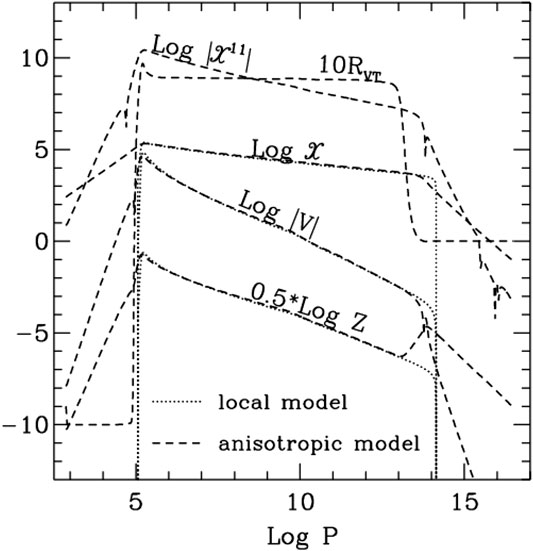
FIGURE 1. Auto- and cross-correlations of turbulent velocity and temperature,
Convective overshooting is different for the different physical variables. It can be seen that turbulent velocity and temperature penetrate deeply into the convectively stable zone. x, Z, and V decrease exponentially with
Remarks About MLT
The local MLT is still a good first approximation for the treatment of convection in the calculation of the thermal structure of stars, when the non-locality and time dependence of convection are not important for the problem concerned. Figure 3 illustrates
Figure 2 illustrates the fractional convective enthalpy and turbulent kinetic fluxes
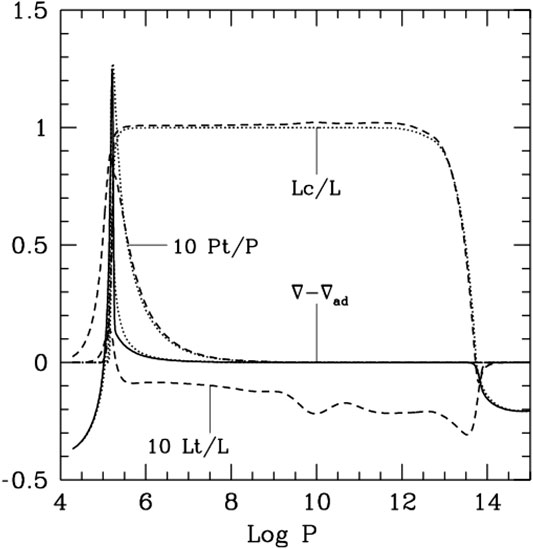
FIGURE 2. Fractional convective flux
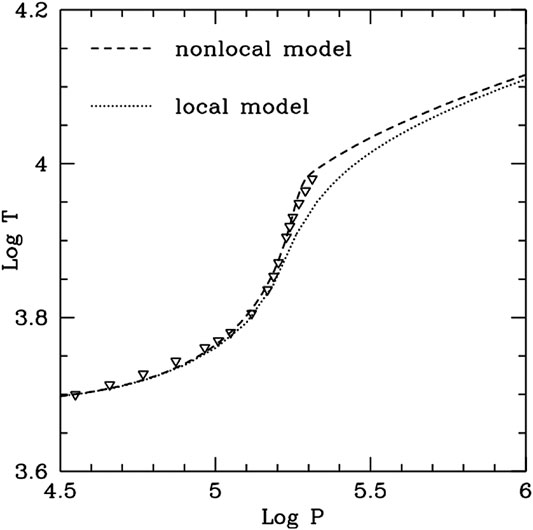
FIGURE 3.
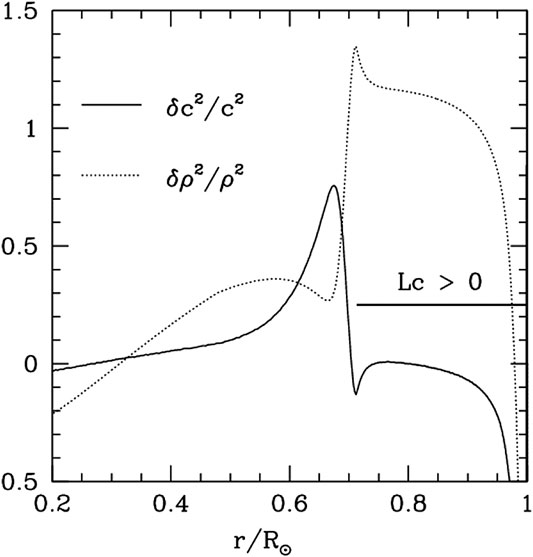
FIGURE 4. Relative difference in the squared sound speed
Structure of the Convective Overshooting Zone
Overshooting is a very natural phenomenon from the viewpoint of hydrodynamics. However, it was an outstanding problem for a long time in the astronomical community. Up to now, the community still cannot cast off the influence of the MLT. The first non-local MLT is the generalized mixing-length theory by Spiegel (Spiegel, 1963). Ulrich (1970) proposed an analogous non-local MLT. Their theories were used to construct a model of the Sun (Ulrich, 1970; Travis and Matsushima, 1973). Observations show that the temperature gradient of their theoretical models were too gentle in the atmosphere of the Sun, because the efficiency of convective energy transport was overestimated by their theory. Figure 3 shows
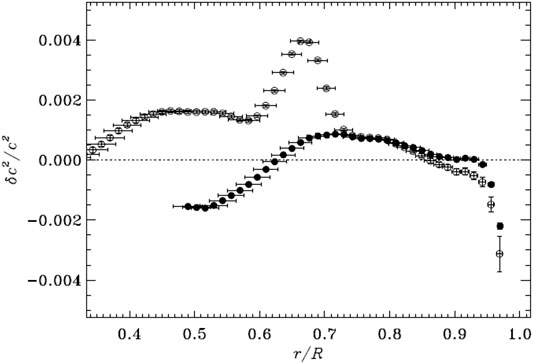
FIGURE 5. Relative differences in squared sound speed between the Sun and the reference model from the sound-speed inversion (Zhang et al., 2012). The open and filled circles are, respectively, for the standard model S (Christensen-Dalsgaard et al., 1996) and our non-local model of the Sun (Xiong and Deng, 2001) as the reference model.
Up to now the MLT is still a dominant idea in the astronomical community. All of the non-local MLT (Spiegel, 1963; Ulrich, 1970; Shaviv and Salpeter, 1973; Maeder, 1975; Bressan et al., 1981; Zahn, 1991) models still use a ballistic-type phenomenological theory. Figure 6A illustrates a sketch of the structure for the bottom overshooting zone of the Sun in the non-local MLT (Monteiro et al., 2000). In the convection zone, the temperature gradient is close to and slightly higher than the adiabatic gradient
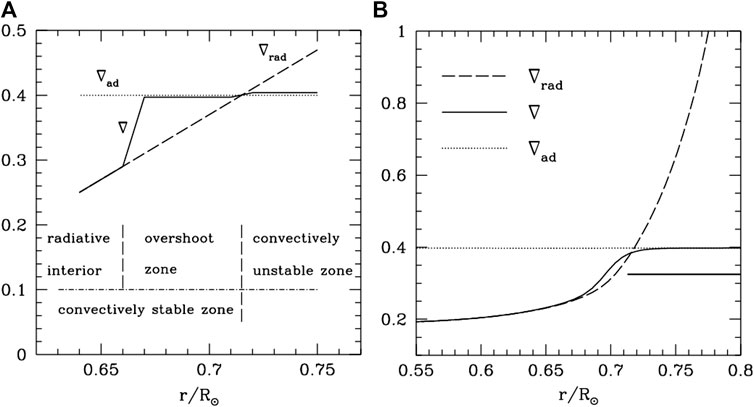
FIGURE 6. The temperature gradient
Eq. 18 is the dynamic equation for the isotropic component of the auto-correlation of turbulent velocity; it can be also understood as the conservation equation of turbulent kinetic energy. The first term is the growth rate of turbulent kinetic energy, which could be set equal to (taking into account minus signs) the sum of the rest of the terms in the equation. The second and third terms are the transformation rate between the average motion and the turbulent kinetic energy. The fourth term is the net gain from the non-local transport of turbulent kinetic energy, which is the key term distinguishing our non-local convection theory from the local theory. The fifth term is the boundary work Wb, which is directly proportional to the convective flux
During the past 20 years, rapid progress has been made in numerical simulations, and these have become an important means to study stellar convection. We have tried to use 2D or 3D simulations to test some basic assumptions of our non-local and time-dependent theory of convection and to calibrate the convection parameters (Kupka, 2002; Deng et al., 2006; Kupka and Muthsam, 2007; Kupka, 2007a; Kupka, 2007b; Kupka, 2007c; Cai, 2008; Tian et al., 2009; Chan et al., 2008; Chan et al., 2011; Cai and Chan, 2012; Cai, 2014; Kupka, 2017; Cai, 2018; Cai, 2020a; Cai, 2020b; Cai, 2020c). Some meaningful results were obtained. Because of limitations on the number of figures, these results cannot be described in detail. Interested readers can refer to the original texts, as well as to extensive reviews by Asplund et al. (2009) and Nordlund et al. (2009).
Overshooting Mixing and Stellar Evolution
We know from the theory of stellar structure and evolution that the stellar structure should be defined once the mass and element abundances of a star are assigned. Therefore, stellar evolution in the H-R diagram is, in fact, a reflection of nuclear evolution in the stellar interior. Convection (including overshooting) is the most important means of element mixing in the stellar interior. Our non-local convection theory has been successfully used to treat non-local convective mixing of elements in the evolution of massive stars (Xiong, 1986) and to calculate lithium depletion in the atmosphere of the Sun (Xiong and Deng, 2002) and late-type main sequence stars (Xiong and Deng, 2009).
Evolution of Massive Stars
Schwarzschild and Härm (1958) have shown that the hydrogen-rich radiative envelope adjacent to the helium-rich convective core cannot be stable against convection for massive stars
where
and the corresponding dynamic equations of auto- and cross-correlations
By using our non-local theory of convection for chemically inhomogeneous stars mentioned above (Xiong, 1981), we calculated the evolution of massive stars in the hydrogen-burning stages (Xiong, 1986). The semi-convection contradiction was indeed removed automatically, as predicted by us. Figure 7 shows the outline of the hydrogen content at various evolution ages for a
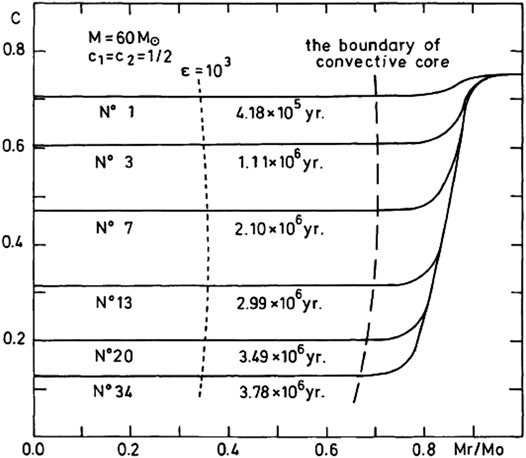
FIGURE 7. Outlines of hydrogen content at various evolution ages for a
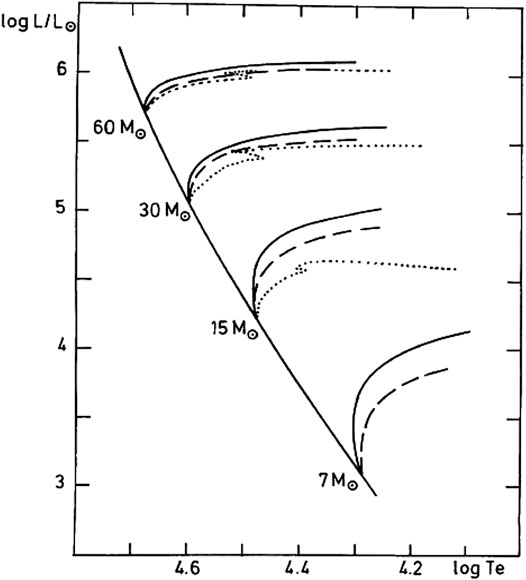
FIGURE 8. Theoretical evolutionary tracks in the H-R diagram for 7–
How one defines the boundary of convective zone is another contributor to the uncertainty in the treatment of non-local convection overshooting, and therefore to the uncertainty in the evolution. For a long time, a disputed question has been whether the criterion for convective instability should follow the Schwarzschild criteria or the Ledoux criteria. Our research shows that the Schwarzschild and Ledoux criteria are only applicable for local convective instability. In our non-local convection theory, the convective instability criterion follows neither Schwarzschild nor Ledoux.
Chiosi et al. studied the mass discrepancy of the Cepheids. They found that “the mass discrepancy problem likely originates from the adoption of semi-convective models and insufficient accuracy in the determination of the mass by one of the two methods. When this is feasible, as in the ideal laboratory given by the young LMC clusters with Cepheids, the discrepancy no longer exists” (Chiosi, et al., 1992). By using the new and improved equation of state (Däppen, et al., 1988; Hummer and Mihalas, 1988; Mihalas et al., 1988) and opacity (Roger and Iglesias, 1992), not only were the excitation mechanism of β Cephei and SPB stars explained (Cox et al., 1992; Moskalik and Dziembowski, 1992; Dziembowski and Pamyatnykh, 1993), but also the mass discrepancy between the evolutionary mass and the “bump” and “beat” masses of the Cepheids was reduced further (Carson and Stothers, 1988; Moskalik and Dziembowski, 1992; Petersen, 1992; Simon, 1995; Guzik et al., 2020).
Lithium Depletion in Late-Type Main Sequence Stars
Lithium abundance was a very important problem for nucleosynthesis during the Big Bang. In addition, lithium and beryllium are both very fragile elements, which are destroyed quickly due to nuclear reaction at T∼2.5 and 4.0 million K in the stellar interior, which makes them ideal trace elements for measuring the depth of the surface convection zone during stellar evolution. Since the original observational detection of the lithium abundance in solar-type stars by Herbig (1965), rich observational data have been accumulated. Observations of the lithium abundance of Galactic open clusters of various ages and metallicities provide very conclusive constraints on the depletion mechanism of lithium. Up to now, the depletion mechanism of lithium in the Sun and stars is still not fully understood. Various depletion mechanisms have been proposed, including mass loss (Weymann and Sears, 1965; Hobbs, et al., 1989; Schramm et al., 1990) and wave-driven mixing (Garcia Lopez and Spruit, 1991; Montalban and Schatzman, 1996), among which rotationally induced mixing (Pinsonneault et al., 1989; Charbonnel et al., 1992; Chaboyer et al., 1995) has been a dominant viewpoint. In our view, convective overshooting mixing and gravitational settling seems to be the most reasonable mechanism for lithium depletion.
By using our non-local theory of convection in chemically inhomogeneous stars described in A Non-Local and Time-Dependent Theory of Convection section and the previous subsection, we calculated the lithium depletion in the atmosphere of the Sun (Xiong and Deng, 2002) and late-type dwarfs (Xiong and Deng, 2009). Apart from convective overshooting, the gravitational settling has been taken into account, because the timescale for gravitational settling in the atmosphere of warm stars becomes comparable to and even shorter than the evolutionary timescale. Referring to Chapman and Cowling (1970), the micro-diffusion flux J of lithium can be expressed as (Xiong and Deng, 2009)
where D and
Figure 9A shows the evolution of surface lithium abundance with age for stars of different masses. We can see that lithium abundance tends to decrease exponentially with time. Figure 9B shows the e-folding time of lithium depletion as a function of stellar mass. The dotted lines are for the models in which only convective overshooting mixing is taken into account and the gravitational settling is neglected; the solid lines are for models with both convective overshooting mixing and gravitational settling. It can be seen that, for larger stars
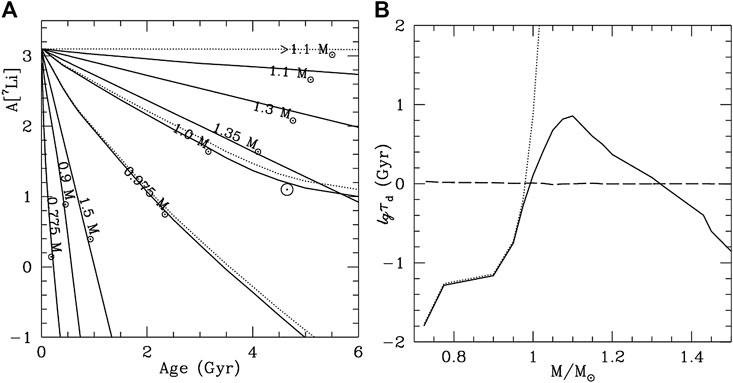
FIGURE 9. (A) Evolution of the surface lithium abundance with age for stars of different masses. The dotted and solid lines, respectively, are for models with only convective overshooting mixing, and for which both gravitational settling and convective overshooting mixing are taken into account. (B) The e-folding time of lithium depletion as a function of stellar mass. The dotted lines are the models for which only the overshooting mixing are taken into account; the solid lines are models in which both overshooting mixing and gravitational setting are taken into account.
Figure 10 shows the lithium abundance versus depth
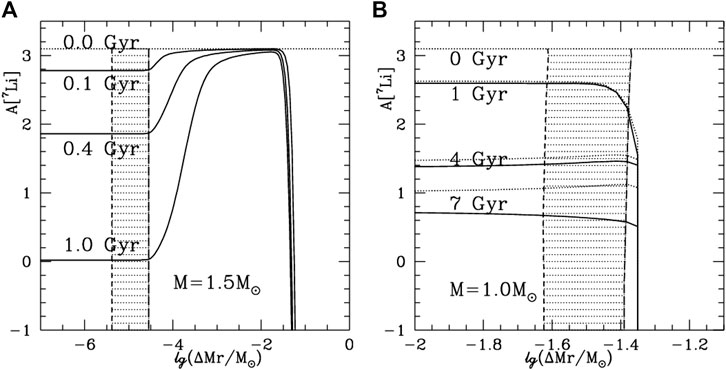
FIGURE 10. Lithium abundances as a function of depth
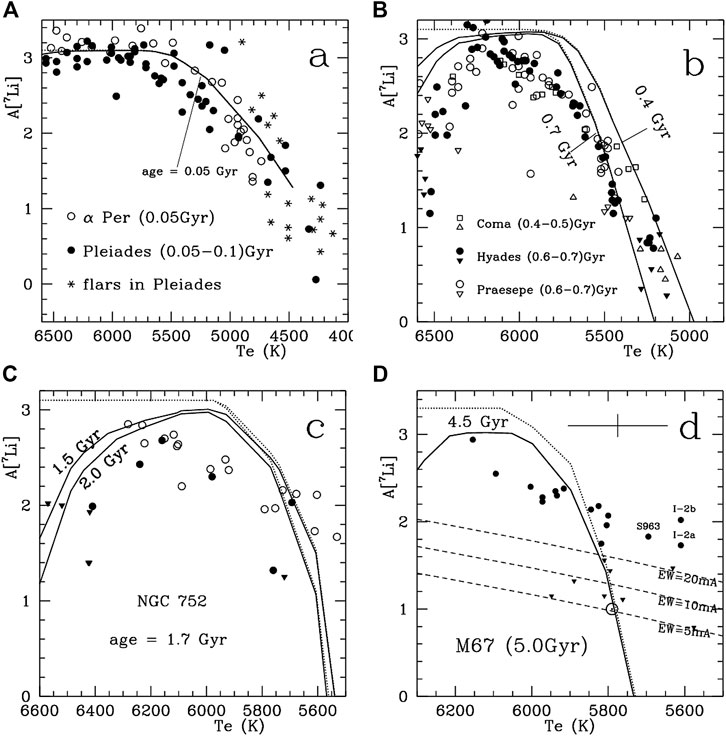
FIGURE 11. Lithium abundance as a function of
Data Availability Statement
The original contributions presented in the study are included in the article/Supplementary Material, further inquiries can be directed to the corresponding author.
Author Contributions
The author confirms being the sole contributor of this work and has approved it for publication.
Funding
This work was supported by National Natual Science Foundation of China (NSFC) through grants 11373069.
Conflict of Interest
The author declares that the research was conducted in the absence of any commercial or financial relationships that could be construed as a potential conflict of interest.
Acknowledgments
We would like to thank L. Deng and C. Zhang for their valuable discussions. We would also like to thank Guzik for her great help in reviewing and revising this article. I dedicate this article to my mentor, Prof. Wasaburo Unno, with gratitude for his attention and support for our work over the years.
References
Alexander, D. R., and Ferguson, J. W. (1994). Low-temperature Rosseland opacities. Astrophys. J. 437, 879. doi:10.1086/175039
Asplund, M., Grevesse, N., Sauval, A. J., and Scott, P. (2009). The chemical composition of the Sun. Annu. Rev. Astron. Astrophys. 47, 481–522. doi:10.1146/annurev.astro.46.060407.145222
Basu, S., and Antia, H. M. (1994). Helioseismic constraints on solar abundances. Mon. Not. R. Astron. Soc. 269, 1437.
Bohm-Vitense, E. (1958). Über die Wasserstoffkonvektionszone in Sternen verschiedener Effektivtemperaturen und Leuchtkräfte. Mit 5 Textabbildungen. Zeitschrift für Astrophysik 46, 108.
Bressan, A., Bertelli, G., and Chiosi, C. (1981). Mass loss and overshooting in massive stars. Astron. Astrophys. 102, 23.
Brun, A. S., Turck‐Chieze, S., and Zahn, J. P. (1999). Standard solar models in the light of new helioseismic constraints. II. mixing below the convective zone. Astrophys. J. 525, 1032. doi:10.1086/307932
Cai, T., and Chan, K. L. (2012). Three-dimensional numerical simulation of convection in giant planets: effects of solid core size. Planet. Space Sci. 71, 125–130. doi:10.1016/j.pss.2012.07.023
Cai, T. (2014). Numerical analysis of non-local convection. Mon. Not. R. Astron. Soc. 443, 3703–3711. doi:10.1093/mnras/stu1357
Cai, T. (2018). Numerical analysis of nonlocal convection-comparison with three-dimensional numerical simulations of efficient turbulent convection. Astrophys. J. 868, 12. doi:10.3847/1538-4357/aae1b3
Cai, T. (2008). Some discussion of the nonlocal treatment of the dissipation in the Reynolds stress models. Proc. Int. Astron. Union 4, 45–46. doi:10.1017/s1743921308022412
Cai, T. (2020a). Upward overshooting in turbulent compressible convection. I. effects of the relative stability parameter, the Prandtl number, and the Péclet number. Astrophys. J. 888, 46. doi:10.3847/1538-4357/ab58c5
Cai, T. (2020c). Upward overshooting in turbulent compressible convection. III. calibrate parameters for one-dimensional Reynolds stress model. Astrophys. J. 891, 77. doi:10.3847/1538-4357/ab7203
Cai, T. (2020b). Upward overshooting in turbulent compressible convection. II. simulations at large relative stability parameters. Astrophys. J. 891, 49. doi:10.3847/1538-4357/ab711c
Canuto, V. M. (1999). Turbulence in stars. III. unified treatment of diffusion, convection, semiconvection, salt fingers, and differential rotation. Astrophys. J. 524, 311. doi:10.1086/307783
Canuto, V. M. (1993). Turbulent convection with overshooting: Reynolds stress approach. II. Astrophys. J. 416, 331. doi:10.1086/173238
Carson, T. R., and Stothers, R. B. (1988). Classical bump Cepheids—reconciliation of theory with observations. Astrophys. J. 328, 196. doi:10.1086/166281
Chaboyer, B., Demarque, P., and Pinsonneault, M. H. (1995). Stellar models with microscopic diffusion and rotational mixing. I: application to the Sun. Astrophys. J. 441, 865. doi:10.1086/175408
Chan, K. L., Cai, T., and Singh, H. P. (2011). Overshooting above a convection zone. Proc. Int. Astron. Union 6, 317–325. doi:10.1017/s1743921311017741
Chan, K. L., and Singh, H. P. (2008). Proxies for overshooting above a convection zone. Proc. Int. Astron. Union 4, 43–44. doi:10.1017/S1743921308022400
Chandrasekhar, S. (1939). An Introduction to the Study of Stellar Structure. Chicago, IL: University of Chicago Press.
Chapman, S., and Cowling, G. (1970). Mathematical theory of non-uniform gases. 3rd Edn. Cambridge, United Kingdom: Cambridge Univ. Press.
Charbonnel, C., Vauclair, S., and Zhan, J. P. (1992). Rotation-induced mixing and lithium depletion in galactic clusters. Astron. Astrophys. 255, 191.
Chiosi, C., Bressan, A., Wood, P. R., Bertelli, G., and Mateo, M. (1992). On the mass discrepancy of the cepheid stars. Astrophys. J. 385, 205–216. doi:10.1086/170928
Christensen-Dalsgaard, J., Däppen, W., Ayukov, S. V., Anderson, E. R., Antia, H. M., Basu, S., et al. (1996). The current state of solar modeling. Science 272, 1286–1292. doi:10.1126/science.272.5266.1286
Christensen-Dalsgaard, J., Di Mauro, M. P., Straka, C., Lebreton, Y., and Monteiro, M. (2007). “Diffusion and Helioseismology,” in EAS Publ. Ser. 26 stellar evolution and seismic tools for asteroseismology--diffusive processes in stars and seismic analysis. Editors C. W. Straka, Y. Lebreton, M. J. P. G. Monteiro, and L. E. S. Ulis (Cambridge, United Kingdom: Cambridge University Press), 3–26.
Christensen-Dalsgaard, J., Monteiro, M. J. P. F. G., Rempel, M., and Thompson, M. J. (2011). A more realistic representation of overshoot at the base of the solar convective envelope as seen by helioseismology. Mon. Not. R. Astron. Soc. 414, 1158–1174. doi:10.1111/j.1365-2966.2011.18460.x
Cogan, B. C. (1970). Pulsation constants for models of cepheids. Astrophys. J. 162, 139. doi:10.1086/150639
Cox, A. N., Morgan, S. M., Rogers, F. J., and Iglesias, C. A. (1992). An opacity mechanism for the pulsations of OB stars. Astrophys. J. 393, 272–277. doi:10.1086/171504
Däppen, W., Mihalas, D., Hummer, D. G., and Mihalas, B. W. (1988). The equation of state for stellar envelopes. III. thermodynamic quantities. Astrophys. J. 332, 261. doi:10.1086/166650
Deng, L., Xiong, D. R., and Chan, K. L. (2006). An anisotropic nonlocal convection theory. Astrophys. J. 643, 426. doi:10.1086/502707
Deng, L., and Xiong, D. R. (2008). How to define the boundaries of a convective zone, and how extended is overshooting? Mon. Not. R. Astron. Soc. 386, 1270. doi:10.1111/j.1365-2966.2008.12969.x
Dziembowski, W. A., and Pamyatnykh, A. A. (1993). The opacity mechanism in B-type stars - II. excitation of high-order g-modes in main-sequence stars. Mon. Not. R. Astron. Soc. 262, 588–600. doi:10.1093/mnras/262.1.204
Garcia Lopez, R. J., and Spruit, H. C. (1991). Li Depletion in F stars by internal gravity waves. Astrophys. J. 377, 268. doi:10.1086/170356
Gingerich, O., Noyes, R. W., Kalkofen, W., and Cuny, Y. (1971). The Harvard-Smithsonian reference atmosphere. Solar Phys. 18, 347–365. doi:10.1007/bf00149057
Gough, D. O., and Sekii, T. (1993). “On the Detection of Convective Overshoot,” in Seismic investigation of the Sun and Stars ASP Conf. Ser. 42. Editor T. Brown (San Francisco, CA: Astron. Soc. Pac.), 177.
Gough, D. O. (1990). “Comments on Helioseismic Inference,” in Lecture Notes in Physics. Editors Y. Osaki, and H. Shibahashi (Berlin, Germany: Springer-Verlag), Vol. 363, 283.
Gough, D. O. (1969). The Anelastic Approximation for Thermal Convection. J. Atmos. Sci. 26, 448–456. doi:10.1175/1520-0469(1969)026<0448:taaftc>2.0.co;2
Grossman, S. A. (1996). A theory of non-local mixing-length convection - III. comparing theory and numerical experiment. Mon. Not. R. Astron. Soc. 279, 305–336. doi:10.1093/mnras/279.2.305
Guzik, J. A., Farag, E., Ostrowski, J., Evans, N. R., Neilson, H., Moschou, S., et al. (2020). Investigating opacity modifications and reaction rate uncertainties to resolve the cepheid mass discrepancy. arXiv2002. 04073.
Henyey, L. G., Forbes, J. E., and Gould, N. L. (1964). A new method of automatic computation of stellar evolution. Astrophys. J. 139, 306. doi:10.1086/147754
Herbig, G. H. (1965). Lithium abundances in F5-G8 dwarfs. Astrophys. J. 141, 588. doi:10.1086/148147
Higgins, E. R., and Vink, J. S. (2020). Theoretical investigation of the Humphreys-Davidson limit at high and low metallicity. Astron. Astrophys. 635, 175. doi:10.1051/0004-6361/201937374
Hobbs, L. M., Iben, I. J., and Pilachowski, C. (1989). On Lithium removal from G dwarfs. Astrophys. J. 347, 817–880. doi:10.1086/168171
Hummer, D. G., and Mihalas, D. (1988). The equation of state for stellar envelopes. I - an occupation probability formalism for the truncation of internal partition functions. Astrophys. J. 331, 794. doi:10.1086/166600
Humphreys, R. M., and Davidson, K. (1979). Studies of luminous stars in nearby galaxies. III - comments on the evolution of the most massive stars in the Milky Way and the Large Magellanic Cloud. Astrophys. J. 232, 409–420. doi:10.1086/157301
Humphreys, R. (1979). Studies of luminous stars in nearby galaxies. II. M supergiants in the large magellanic cloud. Astrophys. J. Suppl. Ser. 38, 309. doi:10.1086/190578
Kupka, F. (2002). A Star Envelopes: a test of local and non-local models of convection. MNRAS 330, 6.
Kupka, F. (2017). Modelling of stellar convection. Living Rev. Comput. Astrophys. 3, 1. doi:10.1007/s41115-017-0001-9
Kupka, F., and Muthsam, H. J. (2007). Probing Reynolds stress models of convection with numerical simulations: III. compressibility modelling and dissipation. Proc. Int. Astron. Union 239, 86. doi:10.1017/S1743921307000191
Kupka, F. (2007b). Probing Reynolds stress models of convection with numerical simulations: II. non-locality and third order moments. Proc. Int. Astron. Union 239, 83. doi:10.1017/S174392130700018X
Kupka, F. (2007a). Probing Reynolds stress models of convection with numerical simulations: I. overall properties: fluxes, mean profiles. Proc. Int. Astron. Union 239, 80. doi:10.1017/S1743921307000178
Kupka, F. (2007c). Some open questions concerning the modelling of non-locality in Reynolds stress type models of stellar convection. Proc. Int. Astron. Union 239, 92. doi:10.1017/S174392130700021X
Ludwig, H. G., Freytag, B., and Steffen, M. (1999). A calibration of the mixing-length for solar-type stars based on hydrodynamical simulations. I. methodical aspects and results for solar metallicity. Astron. Astrophys. 346, 111.
Maeder, A. (1975). Stellar evolution III: the overshooting from convective cores. Astron. Astrophys. 40, 303.
Maeder, A. (1981). The most massive stars evolving to red supergiants - Evolution with mass loss, WR stars as post-red supergiants and pre-supernovae. Astron. Astrophys. 99, 97.
Mihalas, D., Däppen, W., and Hummer, D. G. (1988). The equation of state for stellar envelopes. II - algorithm and selected results. Astrophys. J. 331, 815. doi:10.1086/166601
Montalban, J., and Schatzman, E. (1996). Mixing by internal waves. II. Li and Be depletion rate in low mass main sequence. Astron. Astrophys. 305, 513.
Monteiro, M. J. P. F. G., Christensen-Dalsgaard, J., and Thompson, M. J. (1994). Seismic study of overshoot at the base of the solar convective envelope. Astron. Astrophys. 283, 247.
Monteiro, M. J. P. F. G., Christensen-Dalsgaard, J., and Thompson, M. J. (2000). Seismic study of stellar convective regions: the base of the convective envelope in low-mass stars. Mon. Not. R. Astron. Soc. 316, 165–172. doi:10.1046/j.1365-8711.2000.03471.x
Moskalik, P., and Dziembowski, W. A. (1992). New opacities and the origin of the β Cephei pulsation. Astron. Astrophys. 256, L5.
Nordlund, A., Stein, R. F., and Asplund, M. (2009). Solar Surface Convection. Living Rev. Sol. Phys. 6, 2. doi:10.12942/lrsp-2009-2
Orszag, S. A. (1977). “Fluid Dynamics,”. Editors R. Balian, and J-L. Peube, (London, United Kingdom: Gordon & Breach), 235.
Petersen, J. O. (1992). Studies of cepheid-type variability. X. k-effect-functions for period ratios. Astron. Astrophys. 265, 555.
Pinsonneault, M. H., Kawaler, S. D., Sofia, S., and Demarque, P. (1989). Evolutionary models of the rotating Sun. Astrophys. J. 338, 424. doi:10.1086/167210
Richard, O., Vauclair, S., Charbonnel, C., and Dziembowski, W. (1996). New solar models including helioseismological constraints and light-element depletion. Astrophys. J. 525, 1032.
Rodgers, A. W. (1970). The masses of pulsating stars. Mon. Not. R. Astron. Soc. 151, 133–140. doi:10.1093/mnras/151.1.133
Rogers, F. J., and Iglesias, C. A. (1992). Radiative atomic Rosseland mean opacity tables. Astrophys. J. Suppl. Ser. 79, 507. doi:10.1086/191659
Rotta, J. (1951). Statistische Theorie nichthomogener Turbulenz. Zeitschrift für Physik 129, 547–572. doi:10.1007/bf01330059
Roxburgh, I. W., and Vorontsov, S. V. (1994). Seismology of the solar envelope: the base of the convective zone as seen in the phase shift of acoustic waves. Mon. Not. R. Astron. Soc. 268, 880–888. doi:10.1093/mnras/268.4.880
Schootemeijer, A., Nanger, N., Grin, N. J., and Wang, C. (2019). Constraining mixing in massive stars in the small magellanic cloud. Astron. Astrophys. 625, 132. doi:10.1051/0004-6361/201935046
Schramm, D. N., Steigman, G., and Dearborn, D. S. P. (1990). Main-sequence mass loss and the lithium dip. Astrophys. J. 359, L55. doi:10.1086/185794
Schwarzschild, M., and Härm, R. (1958). Evolution of Very Massive Stars. Astrophys. J. 128, 348. doi:10.1086/146548
Shaviv, G., and Salpeter, E. E. (1973). Convective overshooting in stellar interior models. Astrophys. J. 184, 191. doi:10.1086/152318
Simon, N. R. (1995). “Cepheids: pulsation, evolution, opacity, ASPC series,” in Astrophysical applications of powerful new databases. joint discussion no. 16 of the 22nd. general assembly of the I.A.U. ASP conference series, The Hague, Netherlands, August 22–23, 1994. Editors S. J. Adelman, and W. L. Weise (San Francisco, CA: Astron. Soc. Pac.), Vol. 78, 211.
Spiegel, E. A. (1963). A generalization of the mixing-length theory of turbulent convection. Astrophys. J. 138, 216. doi:10.1086/147628
Stobie, R. S. (1969). Cepheid pulsation--I: numerical technique and test calculations. Mon. Not. R. Astron. Soc. 144, 461–484. doi:10.1093/mnras/144.4.461
Stothers, R. B. (1991). Observational tests of convective core overshooting in stars of intermediate to high mass in the galaxy. Astrophys. J. 383, 820. doi:10.1086/170840
Stothers, R. (1970). Internal structure of upper main-sequence stars. Mon. Not. R. Astron. Soc. 151, 65–80. doi:10.1093/mnras/151.1.65
Tian, C.-L., Deng, L.-C., Chan, K.-L., and Xiong, D.-R. (2009). Efficient turbulent compressible convection in the deep stellar atmosphere. Res. Astron. Astrophys. 9, 102. doi:10.1088/1674-4527/9/1/009
Travis, L. D., and Matsushima, S. (1973). The role of convection in stellar atmospheres. observable effects of convection in the solar atmosphere. Astrophys. J. 180, 975. doi:10.1086/152020
Ulrich, R. K. (1970). The five-minute oscillations on the solar surface. Astrophys. J. 162, 993. doi:10.1086/150731
Unno, W., Xiong, D. R., and Kondo, M.-A. (1985). Preliminary report on the solar convection zone model. PASJ 37, 235.
Weymann, R., and Sears, R. L. (1965). The depth of the convective envelope on the lower main sequence and the depletion of lithium. Astrophys. J. 142, 174. doi:10.1086/148274
Xiong, D. R. (1980). A statistical theory of non-local convection. Chin. Astron. 4, 234. doi:10.1016/0146-6364(80)90004-3
Xiong, D. R., and Cheng, Q. L. (1992). A nonlocal convection model of the solar convection zone. Astron. Astrophys. 254, 362.
Xiong, D. R., Deng, L., and Zhang, C. (2016). Turbulent convection and pulsation stability of stars - II. theoretical instability strip for δ Scuti and γ Doradus stars. Mon. Not. R. Astron. Soc. 457, 3183. doi:10.1093/mnras/stw047
Xiong, D. R. (1989). Radiation-hydrodynamic equations for stellar oscillations. Astron. Astrophys. 209, 126.
Xiong, D. R. (1981). Statistical theory of non-local convection in chemically inhomogeneous stars. Sci. Sin. 24, 234.
Xiong, D. R. (1978). Stochastic theory of turbulent convection in pulsating variables. Chin. Astron. 2, 118. doi:10.1016/0146-6364(78)90009-9
Xiong, D. R. (1986). The evolution of massive stars using a non-local theory of convection. Astron. Astrophys. 167, 239.
Xiong, D. R., Cheng, Q. L., and Deng, L. (1997). Nonlocal time‐dependent convection theory. Astrophys. J. Suppl. Ser. 108, 529. doi:10.1086/312959
Xiong, D. R., Cheng, Q. L., and Deng, L. (1998b). Turbulent convection and pulsational stability of variable stars. II. oscillations of RR lyrae and horizontal branch red variable stars. Astrophys. J. 500, 449. doi:10.1086/305695
Xiong, D. R., Deng, L., and Cheng, Q. L. (1998a). Turbulent convection and pulsational stability of variable stars. I. oscillations of long‐period variables. Astrophys. J. 499, 355. doi:10.1086/305601
Xiong, D. R., and Deng, L. (2009). Lithium depletion in late-type dwarfs. Mon. Not. R. Astron. Soc. 395, 2013–2028. doi:10.1111/j.1365-2966.2009.14581.x
Xiong, D. R., and Deng, L. (2002). The extent of the solar overshooting zone deduced from Li abundance. Mon. Not. R. Astron. Soc. 336, 511–519. doi:10.1046/j.1365-8711.2002.05767.x
Xiong, D. R., and Deng, L. (2001). The structure of the solar convective overshooting zone. Mon. Not. R. Astron. Soc. 327, 1137–1144. doi:10.1046/j.1365-8711.2001.04820.x
Xiong, D. R., Deng, L., and Zhang, C. (2018). Turbulent convection and pulsation stability of stars - III. non-adiabatic oscillations of red giants. Mon. Not. R. Astron. Soc. 480, 2698–2703. doi:10.1093/mnras/sty2014
Zhang, C., Deng, L., Xiong, D., and Christensen-Dalsgaard, J. (2012). Sound-speed inversion of the Sun using a nonlocal statistical convection theory. Astrophys. J. 759, L14. doi:10.1088/2041-8205/759/1/l14
Zhang, Q. S. (2013). Convective overshoot mixing in models of the stellar interior. Astrophys. J. Suppl. Ser. 205, 18. doi:10.1088/0067-0049/205/2/18
Zhang, Q. S., and Li, Y. (2012a). Turbulent convection model in the overshooting region. I. effects of the convective mixing in the solar overshooting region. Astrophys. J. 746, 50. doi:10.1088/0004-637x/746/1/50
Zhang, Q. S., and Li, Y. (2012b). Turbulent convection model in the overshooting region. II. theoretical analysis. Astrophys. J. 750, 11. doi:10.1088/0004-637x/750/1/11
Zhang, Q. S. (2012a). Testing the core overshoot mixing described by a turbulent convection model on the eclipsing binary star HY VIR. Astrophys. J. 761, 153. doi:10.1088/0004-637x/761/2/153
Keywords: convection-stars, evolution-stars, interior-stars, oscillations-stars, variables
Citation: Xiong D-r (2021) Convection Theory and Relevant Problems in Stellar Structure, Evolution, and Pulsational Stability I Convection Theory and Structure of Convection Zone and Stellar Evolution. Front. Astron. Space Sci. 7:438864. doi: 10.3389/fspas.2020.438864
Received: 26 November 2018; Accepted: 28 October 2020;
Published: 14 May 2021.
Edited by:
Joyce Ann Guzik, Los Alamos National Laboratory (DOE), United StatesReviewed by:
Günter Houdek, Aarhus University, DenmarkMarc-Antoine Dupret, University of Liège, Belgium
Copyright © 2021 Xiong. This is an open-access article distributed under the terms of the Creative Commons Attribution License (CC BY). The use, distribution or reproduction in other forums is permitted, provided the original author(s) and the copyright owner(s) are credited and that the original publication in this journal is cited, in accordance with accepted academic practice. No use, distribution or reproduction is permitted which does not comply with these terms.
*Correspondence: Da-run Xiong, eGlvbmdkckBwbW8uYWMuY24=
 Da-run Xiong
Da-run Xiong